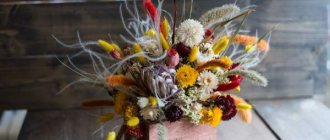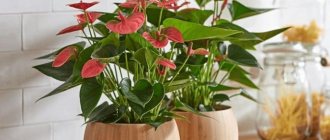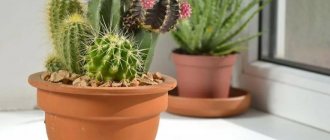A guest from South America, Monstera is a very beautiful decorative vine with large carved leaves. It can often be seen in offices; some people like to grow such a plant in residential premises. There are quite contradictory opinions about the monster. Some consider this plant not only beautiful, but also useful. Others, who believe in omens and superstitions, claim that this plant should not be kept in the house. Some believe that when a monstera is in the house, omens come true, while others grow it and do not observe any negative effects.
Is it possible to keep a monstera at home?
Travelers first spoke about this unusual South American plant at the end of the 15th century.
Flora lovers are afraid to breed monstera in the house. The reputation of this unusual plant is denigrated by many myths, signs and superstitions. The name of the vine is translated as “bizarre”, “amazing”.
Superstitious people compare monstera to a monster. It is believed that philodendron can suck a person’s energy, thereby destroying a family, career and weakening the health of the owner. And yet, is it possible to keep a monstera at home?
It is definitely possible, even necessary. Stories about the negative properties of the flower and scary stories about the green vampire are greatly exaggerated.
Distribution area
Natural habitat - Southern Mexico, tropical forests of Brazil and Guiana.
In addition, in the 19th century it was introduced into Southeast Asia. In wild jungle conditions, its height can reach 30 meters. The long aboveground stem usually twines around tall trees, attaching to the trunk with the help of adventitious aerial roots. When grown in artificial conditions, it has a more modest size - in greenhouses it can reach a size of about 10 meters, in apartments - a maximum of 5.
Leaves
The leaves are large (up to 0.5 meters in diameter), round in shape, pointed at the ends with long flexible cuttings. The leaf plate is dark green in color and covered with slots of different shapes and sizes over the entire surface. The leaves of young representatives of the species are entire and heart-shaped. After reaching a size of 10 cm, deep cuts begin to appear on them.
Roots
The root system consists of a large number of aerial and adventitious roots. The seeds usually germinate in the bark of large trees, on which it grows slowly, like an epiphyte. As it grows, long aerial roots are produced from the base of the main stem, several from each large leaf. Having reached the earthen surface, they bend and produce lateral roots covered with small root hairs.
When the roots become stronger in the ground, the vine begins to grow quickly, twining along the tree on which it sprouted.
Flowers and fruits
The flowering process occurs annually. The flowers are small, bisexual, united in the shape of a spadix, and are formed at the nodes. The color of the buds is white or beige, the core is yellow and has a cylindrical shape. Fruit ripening time is 10 – 14 months. The fruits are edible and have the shape of a cob. The fruits are called berries.
When grown indoors, it is almost impossible to create favorable conditions for flowering. Therefore, almost all photos of flowering vines were taken in natural conditions.
Monstera for the home: good or bad
This exotic plant is perfect for growing indoors. Monstera is a real find for a home or city apartment, especially in a metropolis.
Monstera has the following beneficial properties:
- humidifies and enriches the air in the house with oxygen;
- absorbs small particles of dust, soot and dirt;
- phytoncides secreted by philodendron inhibit the growth and development of bacteria;
- absorbs formaldehyde released from construction and finishing materials;
- absorbs electromagnetic waves emitted by household appliances (modern refrigerators, electric stoves, microwave ovens, TVs, computers and other electrical appliances);
- can warn of natural phenomena; before a rain or thunderstorm, droplets of moisture appear on the leaves of the monstera.
Monstera is a kind of filter for harmful substances, pollution and electromagnetic radiation.
Tips for proper care
A guest from the tropics loves a humid , warm microclimate, good lighting without direct rays. Capricious - does not like touches and drafts. When the air humidity is high or rainy weather is approaching, droplets of water appear on the leaves - a living barometer in the house.
- Watering. Despite the fact that it loves moisture, too much watering is harmful and can lead to rotting of the roots and falling leaves. It is better to periodically spray the leaves and upper roots with moderate watering. By the way, the leaves should be wiped with a soft sponge to remove dust, but only mature ones - young ones should not be used, as they can be damaged.
- Soil and replanting. Neutral and universal soils are suitable for monstera. Young plants are transplanted into larger pots every spring, and when they grow too large, some of the soil in the pot is only renewed without replanting.
- Reproduction. Young plants are easily grown in many ways: from seeds, stem cuttings, leaves, apical cuttings, aerial roots.
- Pests and diseases. Susceptible to spider mites and scale insects. With improper care (overdrying or waterlogging), the leaves may turn yellow and black.
Monstera at home
Magical properties of the plant
Esotericists and psychics are of the opinion that in energetic terms the monstera performs the function of a vacuum cleaner.
Magical properties of the plant:
- philodendron is able to absorb negative energy and transform it into positive;
- the flower eases the torment of a seriously ill person and promotes recovery;
- can cure headaches and relieve terrible migraine attacks.
In Asian countries, vines are often planted near the entrance to the house as a talisman against any evil.
According to the teachings of Feng Shui, the liana helps a person develop intellect, organize thoughts in the head and adds determination.
Possible difficulties of cultivation
Monstera can be affected by the following pests:
- Mealybugs form “cotton” lumps, which are most often located on the lower plate of the leaf or in its axils. The leaves of the affected plant turn yellow and growth stops. Monstera is isolated and treated with drugs against sucking pests every 4-5 days;
- Spider mites also live on the underside of leaves. Its presence is indicated by light green spots, which merge after a while, the leaf turns yellow and falls off. The drug Fitoverm is used for treatment. And for prevention, high humidity is necessary.
Important! Liana does not like frequent rearrangement and touching. Therefore, do not disturb her too often unless absolutely necessary. If improperly cared for, the tropical beauty may experience the following problems:
If not properly cared for, the tropical beauty may experience the following problems:
- Losing leaves is a natural process, but if more leaves are lost than grown, then this is not normal. This may be caused by a lack of light or nutrition;
- Yellowing leaves indicate a lack of nutrition. Their decay is the result of waterlogging;
- if the leaf plate becomes brown and “papery”, then a larger container or higher humidity is needed;
- leaves turn pale from too much light;
- Stretching of the stem and shrinking of leaves causes a lack of lighting;
- A solid leaf plate without slits occurs when there is a lack of fertilizing or light.
Signs and superstitions about the monster
The unusual, terrifying name of a tropical vine is directly associated among people with the word monster. The huge size of the monstera and the bizarre shape of the leaves, reminiscent of tentacles, on a subconscious level cause hostility towards this flower and a feeling of fear.
Signs and superstitions associated with monstera in the house:
- Monstera cannot be grown in a house where there is an unmarried girl;
- in a house where a monstera grows there will be no harmony - husband and wife often quarrel;
- You can’t place Monstera next to your bed - you can die from suffocation;
- the plant feeds on other people's energy, including positive energy, and the owner of the monstera suffers from fatigue and often gets sick.
Not a single superstition has scientific evidence; to believe it or not - everyone decides for themselves.
General
When does it bloom?
Flowering Monstera is a rare sight . It is believed that it is difficult to make it bloom at home.
- diffuse lighting
- regular watering and spraying
- fertile loose soil
- stock pot
- temperature 20-25°C
Monstera blooms annually in summer when conditions are met.
Monstera flower
How does it bloom?
At home, Monstera grows 5 meters in length . Adventitious roots grow and descend from the stem.
Cream flowers appear in summer. A year later, the purple fruits ripen. They are edible and have a tropical fruit aroma and pineapple flavor.
Data
- Native to South America;
- In tropical forests it reaches a height of 30-40 meters;
- Rarely gets sick;
- In demand all over the world;
- Aerial roots provide additional nutrition;
- Grows in partial shade;
- Does not tolerate direct sunlight.
Monstera in its natural environment - in the tropics
Where is the best place to put the plant?
It is better to keep an exotic plant in places where there are a lot of people and bustle. Liana can often be seen in offices, hallways and meeting rooms. And it is right. The special energy of monstera helps to organize thoughts, resolve conflict situations and make decisions. Suitable places in the house for monstera:
- It is recommended to keep this flower in the living room, as the plant absorbs the negative energy of a person and the room;
- to rid the house of external negativity, you should place a philodendron in the hallway;
- if you place the plant in the kitchen, the residents of the house will forget about poor appetite and diseases of the gastrointestinal tract.
It is not recommended to keep the vine in the bedroom. The leaves of the vine are quite large; during the day the plant releases a huge amount of oxygen, and at night, on the contrary, absorbs it. Therefore, it is not recommended to place a flower in small rooms intended for sleep and relaxation.
Possible harm
Monstera - why you can’t keep it at home and its effect on humans
The plant's harm to human health is not scientifically substantiated. Moreover, scientists have conducted research and proven that the plant is harmless if its leaves are not consumed.
There are many rumors and legends surrounding this flower.
Important! If monstera juice gets on the mucous membranes, it will lead to very unpleasant irritation.
How to avoid the consequences predicted in signs.
Yes, indeed, on the Internet you can find various reviews confirming the fact of the negative impact of philodendron on human life. Most likely, this is a banal coincidence, since it is human nature to look for the source of failure in anything but in oneself.
Important! Not a single sign or superstition associated with indoor plants, including monstera, has scientific evidence.
To avoid the consequences predicted in the signs, it is enough to adhere to certain rules.
Advice! If there are animals or small children in the house, it is better to place the pot with philodendron in a place inaccessible to them to eliminate the possibility of them eating the leaves of the vine.
Philodendron leaf sap and microscopic needles can cause skin irritation and damage to the integrity of mucous membranes.
For particularly impressionable individuals and people with a wild imagination, it is not advisable to place a large plant near a place of sleep and rest. The liana will be a wonderful decoration for the kitchen or hallway.
The most important thing is not to try to assign human properties to the plant and identify the plant with an energy vampire.
Is monstera harmful or poisonous to human health: impact on humans
Contrary to popular belief about the bad effects of monstera on health, it has been proven that it is absolutely safe even for people who suffer from allergies.
The myth about the poisonousness of the plant is also slightly exaggerated. Indeed, there are needle-like formations in the leaf tissues. If the juice gets on the mucous membrane, a burning sensation or even poisoning may occur. There are a number of symptoms to determine it:
- Numbness of the mouth
- Throat irritation
- Swelling of the mouth and throat
- Soreness
- Loss of voice
- Dysphagia
It is worth noting that such a reaction is only possible with close contact with the leaves, for example, if you rub the leaf and then rub your eyes or chew it.
Based on the above, we can conclude that the monstera can cause real harm either to pets who like to snack on flowers, or to inquisitive young children without supervision.
Interesting fact: The peoples of Southeast Asia believe in the medicinal power of the plant. Sometimes it is grown precisely in case of illness. Monstera is placed at the patient’s bedside, and sometimes they are even given a leaf to chew.
Reviews why you can’t keep a monstera at home
Elena Timofeeva, 54 years old, Orenburg
About 4 years ago, an exotic monstera appeared in my house. A beautiful flower with wide leaves and aerial roots fits perfectly into the living room interior. I heard a lot of horror stories from friends and relatives about the notoriety of the flower, but I didn’t notice any negative consequences for myself and my family.
Maria Savchenko, 32 years old, Tyumen
All these myths and superstitions are nothing more than a figment of human imagination. My grandmother gave me Monstera as a housewarming gift. A large plant with gorgeous leaves caught my attention. Don't throw such beauty into the trash. 6 years have passed. I didn't notice any negative effects. Everyone is alive and well, my husband is with me, my children and pets are happy. The positive impact is difficult to assess. The only thing I noticed is that the flower really helps get rid of headaches.
Reality
In fact, the indoor plant secretes phytoncides that destroy pathogenic microorganisms. Today there are many varieties of monstera: compact, variegated, with patterns on the leaves. Most often, gardeners prefer the following types:
Is it possible to keep an exotic vine at home? Monstera? Of course yes. But you should know that it develops quickly, requires large areas and high humidity. Therefore, the plant is suitable for offices and hallways of large organizations.
Content Features
For Monstera to feel good at home, you need to keep it under bright, diffused light. It is recommended to place the flower in the east or west. If you keep it on the south side, be sure to shade it with curtains. A lack of sunlight is manifested by dull coloration of the leaves, while the aerial roots lag behind in development. Follow the basic rules.
- Don't move your monstera if it doesn't need it.
- In winter, this crop has a dormant period. The air temperature should be kept within + 14 degrees. Provide the monstera with appropriate conditions.
- Do not allow monstera to be in drafts.
- In spring and summer, water it more abundantly and add clean, settled water.
- In winter, water the flower less often. The soil should not be dry or excessively wet.











